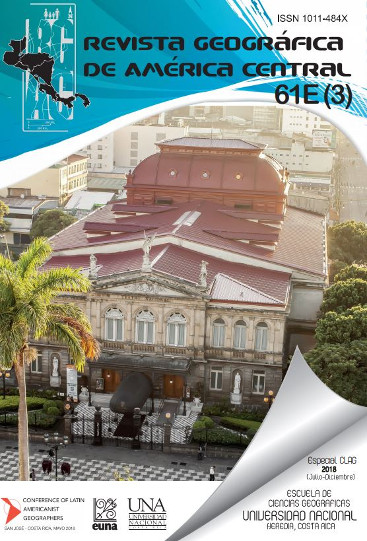Participatory geographic information systems use in Copan Ruinas, Honduras: the development and evaluation of an environmental restoration public participatory Geographic Information System project
DOI:
https://doi.org/10.15359/rgac.61-3.26Keywords:
GIS/PGIS, Public, Participation, Copan, HondurasAbstract
Sustainable development is the challenge of the 21st century, and public administration will play a part in finding new ways of meeting human needs within the constraints of natural resource systems. The nature of sustainable development has led to expanded forms of governance and new partnerships among non-governmental organizations (NGOs), non-profits, and governments at all levels. This paper examines a participatory geographic information system project being developed in Copan Ruinas, Honduras and its effect on the community stakeholders. pecifically, the participatory geographic information system project will focus on the development of a geodatabase and usable maps that integrate: small-scale (less than five hectares on average) agroforestry projects, and highland habitat restoration projects. During this research, we will focus on the geographic information system project, public participation and how the project meets the standards of the International Association for Public Participation (IAP2) pillars of participation and core values.References
Abelson, Julia, and Francois-Pierre Gauvin. Assessing the Impacts of Public Participation: Concepts, Evidence, and Policy Implications. Ottawa: Canadian Policy Research Network, 2006.
Arnstein, Sherry R. "A Ladder of Citizen Participation." The Journal of the American Institute of Planners, July 1969: 216-224.
Dunn, Christine E. "Participatory GIS - a people's GIS?" Progress in Human Geography, 2007: 616-637.
Elwood, Sarah. "Critical Issues in Participatory GIS: Deconstructions, Reconstructions, and New Research Directions." Transactions in GIS, 2006: 693-708.
Fagerholm, Nora. "Whose knowledge, whose benefit? Ethical challenges of participatory mapping." In Fieldwork in the Global South, by Jenny Lunn, 158-169. New York: Routledge, 2014.
International Association for Public Participation. IAP2 Associates Program. March 26, 2017. http://www.iap2.org/?page=A12 (accessed March 26, 2017).
International Association for Public Participation. IAP2 Core Values. March 26, 2017. http://www.iap2.org/?page=A4 (accessed March 26, 2017).
International Association for Public Participation. IAP2's Public Participation Spectrum. March 26, 2017. http://c.ymcdn.com/sites/www.iap2.org/resource/resmgr/foundations_course/IAP2_P2_Spectrum_FINAL.pdf (accessed March 26, 2017).
Kawulich, Barbara B. (May 2005) "Participant Observation as a Data Collection Method." Forum Qualitative Social Research 6, no.2.
Knapp, Connie L. Making Community Connections. Redlands: ESRI, 2003.
Mukherjee, Falguni. "Public Participatory GIS." Geography Compass, 2015: 384-394.
Ramasubramanian, Laxmi. Geographic Information Science and Public Participation. New York, NY: Springer, 2010.
Soen, Dan. "Planning and mediation - Democratic theory and public participation in Israel." Ekistics, June 1997: 60-63.
Published
How to Cite
Issue
Section
License
Proposed policy for journals offering Open Access
Authors publishing their works in the Journal acknowledge and agree to the following terms:
a) Authors retain the copyrights to their works and guarantee the Journal the right to be the first to publish their works, under the Creative Commons License Attribution-NonCommercial-ShareAlike 4.0 International, CC BY-NC-SA 4.0 International (https://creativecommons.org/licenses/by-nc-sa/4.0/deed.es), which allows others to share works upon complying with the acknowledgment of authorship and mention of the Journal as the original publisher of the work.
b) Authors are permitted to separately establish additional agreements for the non-exclusive distribution of the official edition of the work published in the Journal (for example, authors may desire to place the work in an institutional repository or incorporate it into a book that is to published elsewhere) so long they acknowledgment to recognize the Journal as the original publisher. The aforementioned additional agreements must respect the terms of the non-profit character and sharing philosophy of the original license (CC BY-NC-SA 4.0 International, https://creativecommons.org/licenses/by-nc-sa/4.0/deed.es).
c) Authors are encouraged to archive the post-print or editor/PDF version in Open Access repositories.







 REVGEO is licensed under https://creativecommons.org/licenses/by-nc-sa/4.0/deed.es
REVGEO is licensed under https://creativecommons.org/licenses/by-nc-sa/4.0/deed.es
.svg_4.png)

_(1).png)
_(1)_(1)_(1)_1.png)
(2)(1)(1)(1).png)
